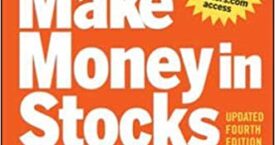Contents:


Before this, Berkshire Hathaway had mostly made money from investing in stocks. For a long time, however, Buffett notes in his1992letter, investors interested in “value” and investors interested in “growth” have been considered to be at odds. But when a company buys back its own stock while it is priced at or above the stock’s intrinsic value, the company is by definition overpaying.
Grateful Olson stitched this together and Buffett has shared so much. Bankruptcy investment in FINOVA in which Berkshire Hathaway led the plan of reorganization with Leucadia which involved a backstop bid at 70c for the takeback notes, but which Berkshire subsequently backed out of due to the September 11 attacks . Mount Everest, K2 and Kangchenjunga are the 3 indisputable tallest mountain ranges out there. It is likely on the bucket list of many new and aspiring climbers, working as a backdrop siren call as they hone their skills on lesser mounds.

“At Berkshire, Charlie and I have long focused on using retained earnings advantageously,” Buffett writes. Among those top 10 Berkshire Hathaway companies, the amount of earnings that are retained and reinvested is more than double the size of the earnings being paid out as dividends. The Washington Post’s stock suffered too, even after Buffett’s acquisition. After the end of 1974, the Post had officially been a loser for Berkshire Hathaway, falling from a value of $10.6M to $8M. But Buffett had a conviction the company’s fortunes would turn, and he knew he had picked up the company at a great price, despite the fact that it had fallen even more.
Berkshire Hathaway Letters to Shareholders, 1965-2018
In his 2019 shareholder letter, Buffett reported that Berkshire Hathaway’s top 10 stock investments had generated almost $3.8B in dividends over the previous year. If investors can do that, they’ll naturally tend to go in the opposite direction of the herd — to “be fearful when others are greedy and greedy only when others are fearful,” as he wrote in 2004. Underlying the actual industry knowledge share, Buffet takes on something of a mentor role for his shareholders https://forexarena.net/ and helps the reader avoid the pitfalls of bad investing, bad reporting and bad business practice. This strategy of train and explain means you will leave this book with a wealth of knowledge you never knew you needed. Warren is a great guy, the kind that you’d love to have as a grandpa – and not in hopes of inheriting a fortune but as someone to learn valuable lessons from. By way of these letters he could be any long-term investor’s virtual grandpa.
I know of no reporting mechanism that would come close to describing and measuring the risks in a huge and complex portfolio of derivatives,” he wrote. The reason that many CEOs use derivatives, Buffett says, is to hedge risks inherent to their business — like Burlington Northern using fuel derivatives to protect its business model against an increase in the price of fuel. When directors have skin in the game, they’re more likely to look out for the company’s best interests. When you have directors who are in it for the money, you’re likely to get an absentee board, and worse outcomes. Buffett’s personal formulation of the strategy is simply “finding an outstanding company at a sensible price” as opposed to finding mediocre companies for cheap prices.
One striking example that he discusses at length in his 1979 letter to shareholders is that of Waumbec Mills in Manchester, New Hampshire. He argues that asset-heavy companies “can be good investments,” with the Burlington Northern Santa Fe Railway and Berkshire Hathaway Energy as prime examples. These two Berkshire-owned companies had combined earnings of $8.3B in 2020. The most common culprits, for Buffett, are the kinds of executives who determine that they’re going to buy a certain amount of stock over a certain period of time. While the technological innovation was even more impressive than the car, the industry as a whole could be said to have failed most of its investors.

So much to learn on investing and really gels wells with my investment philosophy. This is a must read for anyone who wants to seriously consider investing in equities. If you have enough time, this book covers everything you need to know about the value investment, but it is a book require slow and repetitive reading and thinking. Warren’s letter and actions described needs to be related to that context of that year. Don’t read those numerous related books, warren and munger’s original writings are the best. The Little Book of Common Sense Investing by John Bogle There are some investment managers, of course, who are very good – although in the short term, it’s hard to tell whether a great record is due to luck or skill.
Berkshire Hathaway’s Letters to Shareholders 1965-2012
I learned most of the ideas in this investment discussion from Ben’s book The Intelligent Investor, which I bought in 1949. Berkshire utilizes debt, but primarily through its railroad and utility subsidiaries. For these extremely asset-laden businesses that have constant equipment and capital needs, debt makes more sense, and they will generate plentiful amounts of cash for Berkshire Hathaway even in an economic downturn. Much of Berkshire’s early success came down to the intelligent use of leverage on relatively cheap stocks, as a 2013 study from AQR Capital Management and Copenhagen Business School showed. But Buffett’s main problem is not with the concept of debt — it is with the type of high-interest, variable-rate debt that consumer investors must take on if they want to use it to buy stocks. In shareholder letter after shareholder letter, Buffett reminds his readers that the true stars of Berkshire Hathaway are not him or Charlie Munger — they are the managers that run the various companies under the Berkshire Hathaway umbrella.
Buffett’s long-standing belief is that companies that run high-margin operations, require minimal assets, and can expand sales volume with little-to-no extra capital yield the best results. In May, it announced an additional $100B would be spent buying back Apple stock. Coca-Cola’s product has not changed in any meaningful way in over 100 years — just the way that Buffett, as both an investor and as a consumer, likes it. When the car was first invented, a naïve investor might have thought that virtually every automobile stock was guaranteed to succeed. At one point, there were 2,000 separate car brands just in the US.
However, he argues that defining Berkshire as a conglomerate is only partially correct. And in his 2020 letter, Buffett goes on to explain that “conglomerates earned their terrible reputation” and why owning stocks in these businesses may not be the best investment strategy. Buffett concedes that those who invest in companies on the speculation that they may one day be worthwhilecould reap returns — he just has no interest in that kind of investment. He prefers to invest in companies that are already successful and that have a strong chance of continuing success over the long term. Rather than getting too caught up in the price or recent movement of a stock, Buffett says, buy from companies that make great products, that have strong competitive advantages, and that can provide you with consistent returns over the long term. He mocks himself for making mistakes, and sings the praises of Berkshire’s army of CEO-managers.
“Managers of this stripe cannot be ‘hired’ in the normal sense of the word. What we must do is provide a concert hall in which business artists of this class will wish to perform,” he writes. For Buffett, investment bankers are too often simply using whatever math is most preferable for their preferred outcome, whether or not it is deceptive to the buyers and sellers involved in the transaction. Again appear and just as earnestly urge spinning off the earlier acquisition in order to ‘unlock shareholder value,’” he writes.
Full text of Warren Buffett’s annual letter to shareholders – Economic Times
Full text of Warren Buffett’s annual letter to shareholders.
Posted: Sun, 23 Feb 2020 08:00:00 GMT [source]
Because of that, the book is considerably long and if you decide to read it all at once you’ll find some of the year-to-year discussions a little repetitive. This is to be expected, as each letter was originally written to be read with about a year difference, and the overall nature of the business does not usually change that much in this amount of time, but something to be mindful of nonetheless. I learned over many iterations how and why the corporate culture is better in Berkshire than in most other companies. He leads the viewer from the very beginning to today’s state which is an amazing transformation from a declining textile operation to a huge conglomerate holding. It is also detailed why this structure is adventageous, almost to a point where I’d want to buy a few shares.
Buffett Calls 2012 ‘subpar’ In Letter To Shareholders
When I purchased ‘Berkshire Hathaway Letters to Shareholders‘ on 15 November 2013 (for the pricy sum of £2.07) I was not sure what I was in for. All I knew was that I liked Warren’s way of thinking, his approach to business and investing and I wanted to read more from the man directly, not via a biographer or hired hand. I surely would have done a double take if my future self had told me I would take 865 days to finish this thick fat almost 1000 page book. For shareholders and others who are interested, a book that compiles the full unedited versions of each of Warren Buffett’s letters to shareholders between 1965 and 2014 is available for sale at this link. The annual report earlier this week, received plenty of attention, given he…and the economic system.” One of Berkshire’s largest businesses, General Re… The Intelligent Investor by Ben Graham And now back to Ben Graham.
- Often called the “legendary investor, Warren Buffett”, he is the primary shareholder, chairman and CEO of Berkshire Hathaway.
- At the age of 26, a Nebraska stockbroker and school teacher named Warren Buffett took his “retirement fund” of $174,000 and decided to start his own investment business.
- I put this compilation together as a thanks to his positive influence on myself and many, many others.
- That slow-motion crash created a two-year-long bear market — the Dow Jones began 1973 at 1020 and was at 616 by the end of 1974.
- I would suggest to read both, as the former sets the arena or mental framework required and the latter throws you into the field and make you wear your own damn jersey.
- Chinese language edition of Poor Charlie’s Almanack, the ever popular book about my partner.
Going to my first shareholder meeting this May, so reading this was a great way to get the most out of the trip. Our property/casualty (“P/C”) insurance business has been the engine propelling Berkshire’s growth since 1967, the year we acquired National Indemnity and its sister company, National Fire & Marine, for $8.6 million. Today, National berkshire hathaway letters to shareholders Indemnity is the largest P/C company in the world as measured… All of the letters in the book and the examples above were written by Warren E. Buffett and are copyrighted and reprinted with his permission. These letters may not be reproduced, copied, sold or otherwise distributed without the permission of Warren E. Buffett.
Market volatility
You can find most of the letters for free on Berkshire’s website, but this compiles them into a well-designed, easily readable format. It has been claimed by many that you will learn more from reading these letters than getting an MBA. There are hundreds of books about Buffett’s life, advice and methods. These are his true words; “lesson plan” of his views on business and investment. You can find most of the fonts for free on Berkshire’s website, but this one compiles them into a well-designed, easy-to-read format.
The 15 Best Books About Money, Investing, and Personal Finance – Common Cents Mom
The 15 Best Books About Money, Investing, and Personal Finance.
Posted: Wed, 18 May 2022 07:00:00 GMT [source]
In fact, chances are most of these books will be flung across the room well before the last chapter. A lot of them are wilting in bookshelves around the world waiting for a day when the owner inevitably bundles it into the charity box for donation. With over 19 things you can do right now to improve your next party.
Complex financial instruments are dangerous liabilities
H. Brown had to “stand in the shoes of owners” and truly weigh whether the cost of a project was worth the potential results. H. Brown Shoe Company, at the time the leading manufacturer of work shoes in North America. In his shareholder letter that year, Buffett talked about a few of the reasons why. It was really fun to read through the history and see how Buffett went from small time to big time. Knowing the ending didn’t ruin the surprises about which investments panned out and which ones didn’t (some, like Coke, weren’t surprising, but others, like Blue Chip, were more so). Took me like 2 months for the letters and another 2 months for valuation.
Impressively, most all of the content is enjoyable to read too. I’m a bit sad having concluded it though of course can find more subsequent letters to enjoy and learn more. Intense competition in the reinsurance business has produced major losses for practically every company operating in the area. Our underwriting loss was something over 12%—a horrendous figure, but probably little different from the average of the industry. Post that, I read another book named The Essays of Warren Buffett – it is an excellent compilation of all the letters by Lawrence A. Cunningham. His large derivatives stakes involving sales of both single-name and tranche-based credit default swaps and long-dated equity index puts in 2008.
